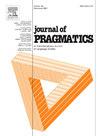“I'm telling you”: The use of interactional metadiscourse in Chinese live streaming commerce
IF 1.7
1区 文学
0 LANGUAGE & LINGUISTICS
引用次数: 0
Abstract
As an emerging form of mediated communication, live streaming commerce (LSC) has established itself as a distinctive business genre. This study examines the use of interactional metadiscourse by streamers in Chinese LSC. Using Hyland's interactional metadiscourse model, we analyzed a corpus of 60 LSC videos sourced from Alibaba's Taobao Live platform to identify patterns and functions of metadiscourse in fostering parasocial interaction. The findings reveal that streamers' promotional speech was rich in interactional metadiscourse. Among stance resources, self-mentions and boosters were used frequently, whereas hedges and attitude markers were less common. Engagement markers mainly included audience references, followed by questions and directives, with minimal use of personal asides and shared knowledge. These metadiscourse resources contribute to parasocial interaction. Stance resources enhance source credibility by presenting streamers as expert and trustworthy product endorsers. Engagement resources foster mutual awareness by cultivating a sense of co-presence between streamers and reviewers in personalized interactions, while also enhancing homophily by highlighting perceived similarities between the two. Collectively, these interactional metadiscourse strategies create an interactive online shopping discourse, fostering a heightened level of parasocial interaction, in which viewers are drawn into in an illusionary, reciprocal communication and form imagined friendships with streamers in the digital space.
“我告诉你”:互动元话语在中国直播商业中的应用
作为一种新兴的媒介传播形式,直播商业(LSC)已经成为一种独特的商业类型。本研究考察了中国语流者对互动元话语的使用。利用Hyland的互动元话语模型,我们分析了来自阿里巴巴淘宝直播平台的60个LSC视频语料库,以确定元话语在促进副社会互动方面的模式和功能。研究结果表明,主播的宣传语具有丰富的交互性元话语。在立场资源中,自我提及和助推器的使用频率较高,而模棱两可和态度标记的使用频率较低。参与标记主要包括听众参考,其次是问题和指示,很少使用个人旁白和共享知识。这些元话语资源有助于辅助社会互动。姿态资源通过将主播呈现为专家和值得信赖的产品代言人来提高来源的可信度。参与资源通过在个性化互动中培养主播和评论者之间的共同存在感来培养相互意识,同时通过突出两者之间的感知相似性来增强同质性。总的来说,这些互动的元话语策略创造了一个互动的在线购物话语,促进了一种高度的准社交互动,在这种互动中,观众被吸引到一种虚幻的、互惠的交流中,并与数字空间中的主播形成想象中的友谊。
本文章由计算机程序翻译,如有差异,请以英文原文为准。
求助全文
约1分钟内获得全文
求助全文
来源期刊

Journal of Pragmatics
Multiple-
CiteScore
3.90
自引率
18.80%
发文量
219
期刊介绍:
Since 1977, the Journal of Pragmatics has provided a forum for bringing together a wide range of research in pragmatics, including cognitive pragmatics, corpus pragmatics, experimental pragmatics, historical pragmatics, interpersonal pragmatics, multimodal pragmatics, sociopragmatics, theoretical pragmatics and related fields. Our aim is to publish innovative pragmatic scholarship from all perspectives, which contributes to theories of how speakers produce and interpret language in different contexts drawing on attested data from a wide range of languages/cultures in different parts of the world. The Journal of Pragmatics also encourages work that uses attested language data to explore the relationship between pragmatics and neighbouring research areas such as semantics, discourse analysis, conversation analysis and ethnomethodology, interactional linguistics, sociolinguistics, linguistic anthropology, media studies, psychology, sociology, and the philosophy of language. Alongside full-length articles, discussion notes and book reviews, the journal welcomes proposals for high quality special issues in all areas of pragmatics which make a significant contribution to a topical or developing area at the cutting-edge of research.
 求助内容:
求助内容: 应助结果提醒方式:
应助结果提醒方式:


